How to choose the right process mining vendor for your business
Process mining is critical for businesses that want to optimize their operations, reduce costs, and improve customer satisfaction. However, choosing the best...

How to achieve the highest return on investment (ROI for your Robotic Process Automation (RPA) project? This is a recurring, integral question for many organizations that are struggling to fully exploit the capabilities of RPA.
Although RPA has been considered a silver bullet for many organizations' digital transformation initiatives, there are reports from leading consulting firms such as EY or PwC saying half of the RPA projects fail in getting the desired ROI. The reasons for these failures may vary from the implementation team's human errors to technology-related issues.
See the on-demand webinar in this topic and download the presentation slides here.
Writer's notes: This blog post was originally published in April 2020, and has been updated in 2022 for accuracy and comprehensiveness.
With over 30 years of experience in process excellence, we at QPR Software have witnessed many of our customers struggle to implement efficient process automation and fail to achieve the desired ROIs. This blog post will uncover the root causes of the most common RPA issues by answering these following questions:
1. What is RPA?
2. What are the common pitfalls in RPA implementation?
3. What are the common approaches to RPA?
4. How to identify RPA opportunities?
5. How can you utilize Process Mining in your RPA project?
Gartner (2019) defines RPA as a productivity tool that allows users to set up one or more scripts (which is also known as "bots") to mimic selected tasks within a business or IT process. RPA often uses a combination of UI interaction and descriptor technologies over several software applications to: manipulate data, trigger responses, execute transactions, and transport data among different applications.
Interestingly, if you consider the nature of this productivity tool, we should call it robotic 'task' automation instead of robotic 'process' automation, because you put the computer to perform individual small tasks that were before done by a human. Nonetheless, these bots ultimately help you make the processes more efficient.
It's no secret that finding the suitable process for RPA is the key to automation success. However, it's often difficult to gain comprehensive understanding of how a process is actually performed in your organization through workshops and interviews. People, unlike data, are biased.
This is where Process Mining steps in. Process Mining collects data from the event logs in your organization's systems. In other words, it gives you a big picture of your end-to-end processes, whether they have been executed by humans or bots.
The benefits of using Intelligent Process Mining in RPA projects are twofold. One, it identifies the process inefficiencies, bottlenecks, as well as RPA opportunities in your processes. Two, it monitors and configures tasks performed by bots, predicts process outcomes and suggests the next required actions to the process owner to fix any RPA problems before they happen.
Read the "Whats, Whys, and Hows of process mining" on our pillar page.
Check out our "What is process mining?" blog post.
Although RPA has been considered a silver bullet for many organizations' digital transformation initiatives, there are reports from leading consulting firms such as EY or PwC saying half of the RPA projects fail in getting the desired ROI. The reasons for these failures may vary from the implementation team's human errors to technology-related issues.
From our extensive experience in supporting large organizations worldwide with their RPA implementation projects, we realize most RPA failures stem from choosing the "wrong process" to automate:
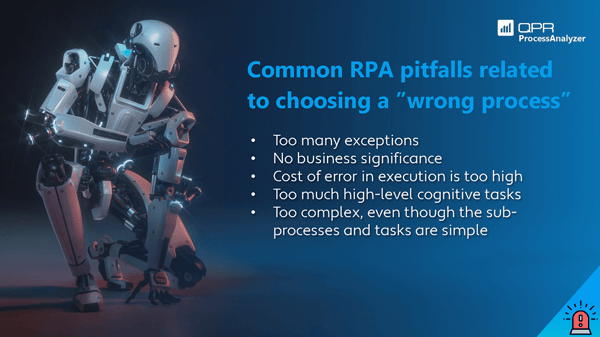
As mentioned in our last blog post (Best Practices for Process Mining in Large Organizations), it may take 80% of your organization's efforts to solve the exception-cases that account for only 20% of your business volume. From the RPA implementation perspectives, if you put a robot into a process with too many exceptions, your RPA project's likely to fail to achieve the desired ROI. As you have to constantly reconfigure the bots to behave in different situations, you may lose millions euros in downtime, maintainence and support.
Process Mining allows you to see how many cases of exceptions you have in your processes and the root causes for these exceptions. You can use Process Mining to decrease the number of exceptions, as well as successfully pinpoint the tasks most suitable for automation to minimize downtime.It's common sense not to invest in a process of little business significance. However, it's possible that these processes have influence over other important processes. Again, an in-depth understanding of your end-to-end process is highly essential for you to find the right process for automation.
For some particular tasks, it's simpler not to have bots implemented although it would mean having a human to double-check each task. With Process Mining, you can easily identify these tasks in your end-to-end process through a holistic view of all processes happening in your organization.
In these situations, you'll need an Intelligent Process Mining software, such as QPR ProcessAnalyzer, to deploy necessary machine learning features such as Clustering Analysis and Predictions to monitor the automation process.
There are basically two ways you can implement RPA in your organization: Automate your whole end-to-end process, or automate individual tasks in a particular process.
Some processes may take up to tens of months to complete and consist of hundreds of different tasks. It's never a good idea to try to automate a whole end-to-end process like this, because that's not what RPA is designed for. As mentioned above, RPA is a productivity tool to execute individual small tasks that were previously done by human. Automating your whole process is an over-ambitious approach that will cost you tons of money, time and effort, and can also negate your ROI.
The best way to implement RPA in your organization is to divide your processes into tasks, and automate some of these tasks, to improve your whole process. But how do you find these tasks? If your answer is Process Mining, you're right.
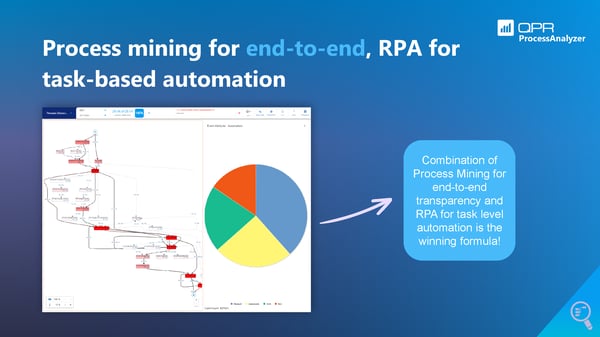
When you use Process Mining to gain the transparency of your whole end-to-end processes, you can easily identify these three kinds of opportunities that are perfect to implement automation on:
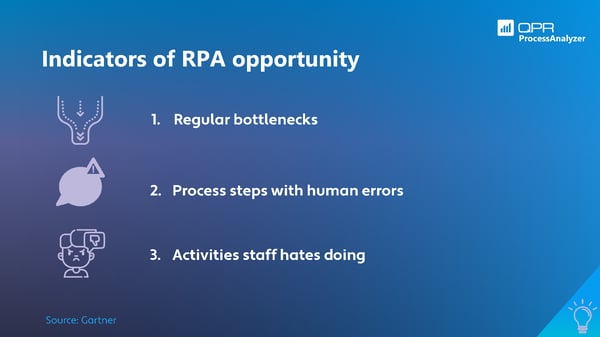
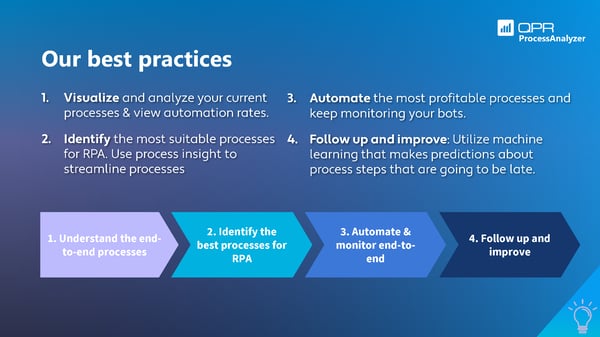
From our experience of helping our customers with their RPA projects, there are four primary steps to utilize Process Mining in RPA implementation:
In order to help you kickstart a successful RPA implementation using Process Mining, QPR Software offers you a free, exclusive 11-page guide: "Four steps of RPA Implementation Using Process Mining":
It’s a good time to learn about Intelligent Process Mining if you haven't already. It can help you identify and prioritize the most suitable and profitable processes for automation. The capabilities and usability of Intelligent Process Mining software, such as QPR ProcessAnalyzer, are improving rapidly, and the market is quickly becoming mature.
If you think your company is ready to step it up with the future of as-is process modeling and process efficiency maximization, the fastest way to get things moving is follow these steps:

Marketing manager in Process Mining at QPR Software.

Process mining is critical for businesses that want to optimize their operations, reduce costs, and improve customer satisfaction. However, choosing the best...
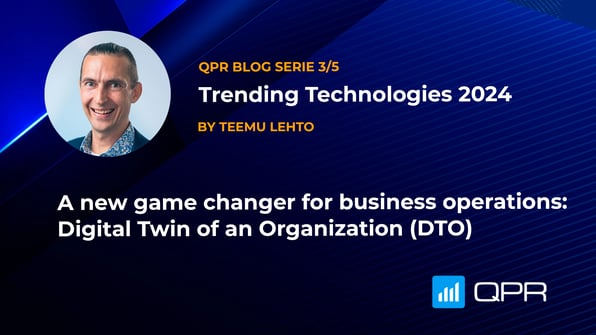
Are you considering creating a Digital Twin of an Organization to transform your company into a digital organization? Learn the what, why, and how in this blog...

The importance of a company's data strategy in relation to its process mining decisions cannot be overstated.
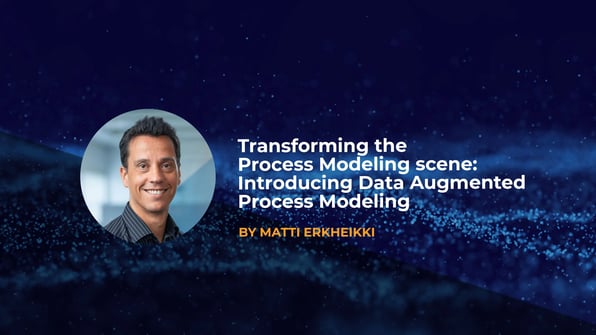
In today's challenging business landscape, efficiency is the key to staying competitive. At QPR, we're constantly evolving to meet the dynamic needs of our...
Featured Webinar
Learn how process mining helps you achieve the highest ROIs in your RPA projects by identifying the most suitable processes for RPA, fully monitoring RPA bots and detecting common RPA pitfalls.
Watch on-demand webinar

